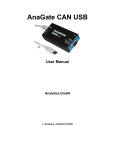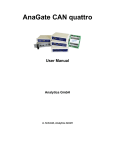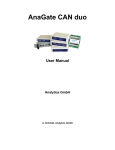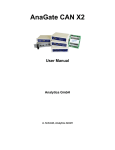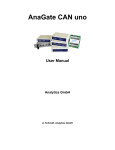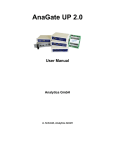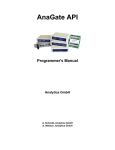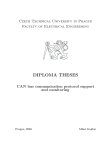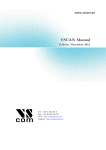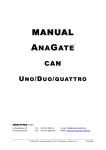Download Analytica GmbH AnaGate CAN duo User manual
Transcript
AnaGate CAN quattro User Manual Analytica GmbH A. Schmidt, Analytica GmbH AnaGate CAN quattro: User Manual Analytica GmbH by A. Schmidt This document was generated with DocBook at 2010-10-14 18:02:02. PDF-Datei (dtsch.): AnaGate-CAN-quattro-1.4.pdf PDF-Datei (engl.): AnaGate-CAN-quattro-1.4-EN.pdf Publication date 10. August 2010 Copyright © 2007-2010 Analytica GmbH Abstract This manual describes the intefaces and modes of operation of a AnaGate CAN quattro. All rights reserved. All the information in this manual was compiled with the greatest of care. However, no warranty can be given for it. No parts of this manual or the program are to be reproduced in any way (printing, photocopying, microfilm or any other process) without written authorisation. Any processing, duplication or distribution by means of any electronic system is also strictly prohibited. You are also advised that all the names and brand names of the respective companies mentioned in this documentation are generally protected by brand, trademark or patent laws. Analytica GmbH Vorholzstraße 36 76137 Karlsruhe Germany Fon +49 (0) 721-43035-0 Fax +49 (0) 721-43035-20 <[email protected]> www.analytica-gmbh.de [http://www.analytica-gmbh.de] www.anagate.de [http://www.anagate.de] Revision History Revision 1.0 08.02.2008 Uwe Initial version Revision 1.1 23.07.2008 Uwe Integration AnaGate CAN duo Revision 1.2 17.04.2009 ASc Integration AnaGate CAN quattro Revision 1.3 18.05.2009 ASc Description Firmware-Update added Revision 1.4 10.08.2010 ASc Manual changed to DocBook format Table of Contents Introduction ..................................................................................................................... vi 1. Description .................................................................................................................... 1 1.1. Features .............................................................................................................. 1 1.2. Specification ........................................................................................................ 2 1.3. Scope of delivery ................................................................................................. 2 1.4. Interfaces and plugs .............................................................................................. 3 2. Configuration ................................................................................................................. 5 2.1. Initial installation ................................................................................................. 5 2.2. Network settings .................................................................................................. 6 2.3. CAN settings ....................................................................................................... 6 2.4. Functional extensions based on LUA ....................................................................... 8 2.5. Digital IO ........................................................................................................... 9 2.6. Firmware update ................................................................................................. 10 2.7. Factory reset ...................................................................................................... 10 3. Fields of application ...................................................................................................... 12 3.1. Gateway mode ................................................................................................... 12 3.2. Bridge mode ...................................................................................................... 13 A. FAQ - Frequent asked questions ..................................................................................... 15 B. Technical support ......................................................................................................... 17 Abbreviations ................................................................................................................... 18 Bibliography ................................................................................................................... 19 iii © 2007-2010 Analytica GmbH List of Figures 1.1. 1.2. 2.1. 2.2. 2.3. 2.4. 2.5. 2.6. 3.1. 3.2. Front view, AnaGate CAN quattro .................................................................................. 3 AnaGate CAN quattro, back panel ................................................................................... 4 HTTP interface, AnaGate CAN uno ................................................................................. 5 HTTP interface, network settings .................................................................................... 6 HTTP interface, CAN settings ........................................................................................ 7 HTTP interface, LUA settings ........................................................................................ 8 Pin layout, digital IO plug ............................................................................................. 9 AnaGate CAN Gateway, Example blinking output ............................................................ 11 AnaGate CAN Gateway in gateway mode ....................................................................... 12 AnaGate CAN Gateway in bridge mode ......................................................................... 13 iv © 2007-2010 Analytica GmbH List of Tables 1.1. Technical data, AnaGate CAN quattro ............................................................................. 2 1.2. Pin layout, CAN plug ................................................................................................... 3 A.1. Using AnaGate hardware with firewall .......................................................................... 16 v © 2007-2010 Analytica GmbH Introduction This document describes the features and objectives of the CAN-Ethernet gateway AnaGate CAN quattro. This device is part of a product line, whose single devices only differ in the number of CAN interfaces and/or the device case. In this manual the term AnaGate CAN Gateway is uniformly used, if no specific modell is addressed or it is not necessary to differentiate. Otherwise the full product name is used, like AnaGate CAN uno, AnaGate CAN duo or AnaGate CAN quattro. vi © 2007-2010 Analytica GmbH Chapter 1. Description The AnaGate CAN Gateway connects a PC, an embedded PC or other general device one or more CAN busses via the TCP/IP network protocol. It basically works as a CAN master with no own CAN identifier on the bus. Controlling and configuration of an AnaGate CAN Gateway is made through TCP/IP. The application protocol itself is described in detail (see [TCP-2010]). Thus the access to the device can be programmed via native calls to the TCP/IP socket interface. This means that any communication partner with a LAN interface is able to communicate to the device. Accessing the AnaGate CAN Gateway with the supplied application libraries for Windows and Linux are much comfortable and can be used with conventional programming languages. In bridge mode the AnaGate CAN Gateway can interconnect two physically independent CAN networks via LAN/Ethernet (LAN bridge mode). With the coupling over LAN/Ethernet it is possible to connect separate CAN buses with different baud rates over long distances. Note The AnaGate CAN duo and AnaGate CAN quattro can additionally interconnect two internal CAN interfaces (internal bridge mode). 1.1. Features • The AnaGate CAN quattro can send and receive CAN messages via its four existing CAN interfaces independantly. This can be done using a device that supports TCP sockets (like a personal computer or a PLC). • Variable CAN bus speed per interface (10, 20, 50, 62.5, 100, 125, 250, 500, 800 or 1000 kbps). • Software configurable bus termination for each CAN interface. • Two different plugs for voltage supply. • System is addressed using a proprietary network protocol. • Static or dynamic assignment (DHCP) of IP address. • 4 digital inputs and outputs, which can be accessed via LAN/Ethernet (except AnaGate CAN USB and AnaGate CAN uno (DIN rail)). • Several simultaneous network connections (4x TCP and 1x UPD) are supported on each existing CAN interface. • Coupling of two independent CAN networks via the LAN/internet via a LAN bridge over two seperate devices. All devices of the AnaGate product line except the AnaGate CAN USB support this feature. • Coupling of two independent CAN networks via the internal CAN/CAN bridge (only AnaGate CAN duo and AnaGate CAN quattro). 1 © 2007-2010 Analytica GmbH Description 1.2. Specification Table 1.1. Technical data, AnaGate CAN quattro Technical aspect Measurements CAN bus Digital IO LAN interface Voltage supply Ambient temperature Specfication Desktop casing 155mm x 105mm x 40mm , fixable on DIN rail with optional adapter kit Weight approx. 175g Baud rate 10, 20, 50, 62.5, 100, 125, 250, 500, 800 or 1000 kbps, software configuration CAN controller 4x Microchip MCP 2515 CAN interface 4x ISO 11898-2 galvanic decoupled Interface 4x pluggable clamp (4-pole) incl. CAN_H and CAN_L Inputs 4, galvanic decoupled (3,3 – 24V) Outputs 4, galvanic decoupled, 3,3 – 24V (Itotal max = 0,5A) Baud rate 10/100 Mbps TCP/IP Static or dynamic (DHCP) IP address Interface RJ45 socket Voltage 9V-28V direct current Power consumption max. 350 mA (9V) without plugged USB consumers Storage 0 .. 85 °C In operation 0 .. 60 °C (industrial version: -20 .. 70°C) Note Protect the AnaGate CAN Gateway from direct sunlight. 1.3. Scope of delivery The AnaGate CAN Gateway is supplied with the following components: • 1x AnaGate CAN Gateway • 1x CD with manual, programming API for Windows/Linux and CANopen driver for CANFestival • 1x 1,8 m Cat. 5 LAN cable (standard, not crossed) • 1x 10 pole Wago plug connector (for digital IO) • 4x 4 pole plug connector for CAN interface • 1x 2 pole Wago plug connector (for external power supply) • 1 x plug-in power supply unit, compatible with country of delivery: EU, US or UK . 2 © 2007-2010 Analytica GmbH Description 1.4. Interfaces and plugs 1.4.1. AnaGate CAN quattro - front view Figure 1.1. Front view, AnaGate CAN quattro The front panel of the AnaGate CAN Gateway features for each existing CAN interface, the following connectors and LEDs (from left to right): Activity LED This green LED lights up on activity on the relevant CAN line. CAN port 4 pole plug to connect the CAN bus. The corresponding connector plug is included in delivery (screw terminal up to 1,5mm²). The pin allocation of the plug can be inferred from the following table. Table 1.2. Pin layout, CAN plug Pin Description 1 GND 2 CAN_L 3 not connected 4 CAN_H 3 © 2007-2010 Analytica GmbH Description 1.4.2. AnaGate CAN quattro - rear view Figure 1.2. AnaGate CAN quattro, back panel The rear panel of the AnaGate CAN Gateway features the following connectors and LEDs (from left to right): Power LED This green LED lights up when voltage is being supplied. Power supply The AnaGate CAN Gateway can be power supplied in two different ways. For the use as desktop device the barrel connector socket is intended, in order to supply the device via a plug power supply For the use in a switchboard the two-pole Wago clamping socket can be used to connect an external power supply. Warning Be sure to use only one power supply. LAN Via the RJ45 socket the AnaGate CAN Gateway is connected with the Ethernet. The device can be connected to a network component like a hub or a switch. For a direct connection to a PC a crossover network cable has to be used. USB Hosts The AnaGate CAN Gateway has two USB 1.1 interfaces for further extensions or customer specific solutions. Digital IO The AnaGate CAN Gateway has 4 digital inputs and 4 digital outputs which can be used freely. The digital io are galvanically decoupled from the device and must be externally power supplied from 3,3V to 24V (see Section 2.5, “ Digital IO”). Reset The AnaGate CAN Gateway can be reset to the factory settings using this button (see Section 2.7, “ Factory reset” for further details). Activity LED This yellow LED lights up when the AnaGate CAN Gateway is processing incoming CAN messages. 4 © 2007-2010 Analytica GmbH Chapter 2. Configuration 2.1. Initial installation First the AnaGate CAN Gateway must be supplied via the power plug with a tension from 9 to 24 V. Insert the included LAN cable into the plug labelled LAN and connect it either to a hub or switch. If connecting to a PC use a crossover LAN cable (not in scope of delivery) instead of the included LAN cable. The AnaGate CAN Gateway is delivered with the following initial network settings: IP address Address type Network mask Gateway 192.168.1.254 static 255.255.255.0 192.168.1.1 The device can now be configured using a standard browser (Internet Explorer, Firefox, etc.) by using http://192.168.1.254. Figure 2.1. HTTP interface, AnaGate CAN uno Note The PC used for the configuration must be in the 192.168.1.x network. The static IP address 192.168.1.2 with the subnet mask 255.255.255.0 can be e.g. used. If neccessary the settings of the network interface on the configuration pc has to be changed temporarily. 5 © 2007-2010 Analytica GmbH Configuration 2.2. Network settings On the page IP Settings the following settings can be changed. DHCP Here you can switch between static IP and dynamic (via DHCP) addresses. If DHCP is being used, the remaining fields are ignored, because this information is retrieved from the DHCP server. In this case, a DHCP server must be available and accessible in the network. IP address The IP address of the AnaGate CAN Gateway is entered in a.b.c.d format (e.g. 192.168.1.200). Subnet mask The subnet mask is entered in a.b.c.d format (e.g. 255.255.255.0). Gateway The default gateway is entered in a.b.c.d format (e.g. 192.168.1.1). Leave blank or enter 0.0.0.0 if a default gateway is not required. Figure 2.2. HTTP interface, network settings The inputs will be taken over immediately after clicking the button Save settings and saved permanently on the AnaGate CAN Gateway. A restart of the device is not necessary for activation of the settings. Note Maybe the ARP cache of the PC has to be deleted to find the device with the changed IP address. 2.3. CAN settings On the page CAN Settings the global settings for all existing CAN interfaces are displayed and can be changed individually. 6 © 2007-2010 Analytica GmbH Configuration Figure 2.3. HTTP interface, CAN settings Baudrate The baud rate can be selected easily via a list box containing all supported values. Termination Use the check box to switch on/off the internal termination resistor. High Speed Activates/deactivates the Highspeed mode. In this operating mode all incoming/outgoing CAN telegrams are not longer confirmed by the opposite LAN side to accelerate process throughput. Software-Filters are switched off too in this mode. Bridge Activates/deactivates the bridge mode (see Section 3.2, “ Bridge mode”). to IP IP address of the partner device, to which a connection (bridge) is to be made (only Bridge Modus). at Port Port of the partner device, to which a connection (bridge) is to be made (only Bridge Modus). 7 © 2007-2010 Analytica GmbH Configuration Remote-Baudrate Baudrate of the partner device, to which a connection (bridge) is to be made (only Bridge Modus). Remote-Termination Terminierung of the partner device, to which a connection (bridge) is to be made (only Bridge Modus). The inputs will be taken over immediately after clicking the button Save settings and saved permanently on the AnaGate CAN Gateway. A restart of the device is not necessary for activation of the settings. 2.4. Functional extensions based on LUA On a AnaGate CAN quattro it is possible to execute self-created applications with an installed LUA script interpreter (see [Prog-2010] for a detailed description of all programming features). On the page LUA LUA script files can be downloaded to the device and executed locally. Figure 2.4. HTTP interface, LUA settings 8 © 2007-2010 Analytica GmbH Configuration Browse... Opens a file upload dialog to select a LUA script file. Upload Uploads the selected script file to the device. Clear Clears the current script file selection. Boot script Script file executed on system startup. Via the button Delete the boot script can be deactivated. Only one boot script is allowed. Running script Displays the currently executing script file. Via the button Stop the execution can be cancelled. Available scripts Displays all scripts which are currently available on the device. To start the execution of a script click on the button Start. Via button Delete a script can be deleted on the device and via Boot a script can be defined as boot script. script output area In this text area the standard output (stdout) of the currently executing script is displayed. Via the button Clear this text area can be cleared. error output area In this text area the standard error output (stderr) of the currently executing script is displayed. Via the button Clear this text area can be cleared. Tip The text areas for script and error output are not refreshed automatically. A manual page reload of the current page refreshes both text areas. 2.5. Digital IO Over the 10-pole pin row on the back of the AnaGate CAN Gateway four digital inputs and four digital outputs are led out, which can be used freely. Since the IO's are electrically isolated from the AnaGate CAN Gateway, they must be separately supplied via the pins 1 us 2 with a voltage by 3,3V - 24V DC. Figure 2.5. Pin layout, digital IO plug 2.5.1. Connecting the digital inputs At the inputs IN1 to IN4 any external voltage between VCC and GND can be applied. As soon as the voltage difference between INx and GND is more than 1.0 V, the AnaGate CAN Gateway interprets the input as logically HI otherwise LOW. 9 © 2007-2010 Analytica GmbH Configuration 2.5.2. Connecting the digital outputs The outputs are implemented as open collector drivers. If a output is active, it is pulled down to GND. In the inactive condition the output is floating. In principle the maximum current of each individual output is 400mA. For thermal reasons is the sum of all output currents is limited to 500mA. The outputs not short-circuit proofed, and must be protected with a pre-resistor. 2.6. Firmware update Use the Firmware page to load a new firmware to the AnaGate CAN Gateway. Please visit our Web site http://www.anagate.de for further information. 2.7. Factory reset In order to restore the default factory settings, hold the RESET for approx. 10 seconds. If the device is reset successfully, the yellow LED blinks until the RESET is released. The default factory settings are activated immediately without a restart of the device: IP address Address type Network mask Gateway 192.168.1.254 static 255.255.255.0 192.168.1.1 Important If the RESET push-button is pressed too briefly, the actual IP address and network mask is pulsed via the yellow LED (Morse code). A second push of the RESET, terminates the pulsing, the device is not reset. Note The factory reset is not possible directly after power on until complete loading of operating system and firmware of the device. This initialization period is signalled via the yellow activity LED. On power on the LED is switched on and after initialization the LED is switched off. Note Maybe the ARP cache of the PC has to be deleted to find the device with the changed IP address. 2.7.1. Examining the network settings It is possible to check the current network settings directly on the device. After pressing shortly the RESET button the device starts to pulse out the current n settings via the yellow activity LED. Pressing again the buttons stops the pulsing immediately. The IP address and subnet mask are pulsed out, one after the other. Following pulse codes are used: 10 © 2007-2010 Analytica GmbH Configuration • Digits 1, 2, 3, ...., 9: 1x, 2x, ...9x Flashing (200ms delay between each flash) • Digit 0: 10x flashing (200ms delay between each flash) • Dot: 1x very fast flash Between two single digits a delay of 1 seconds is made, and between the IP address and subnet mask two fast flashes are pulsed out. Figure 2.6. AnaGate CAN Gateway, Example blinking output 11 © 2007-2010 Analytica GmbH Chapter 3. Fields of application If the AnaGate CAN Gateway is connected to the CAN bus, mind the following facts: • CAN_L: This line has to be connected to the CAN_Low line of the CAN bus. • CAN_H: This line has to be connected to the CAN_High line of the CAN bus. • GND: This line can be connected optionally to GND of the other bus devices. 3.1. Gateway mode In gateway mode the CAN messages are transferred transparently over TCP/IP between the CAN network and the host platform (e.g. PC) in both directions. The AnaGate CAN Gateway uses no unique CAN ID when sending telegrams, this ID has to be set explicitly for each transmitted message. All CAN messages received by the device are transmitted to all active LAN-connected host systems. It is possible to discard all incoming messages in general or to set individual software filters to reduce the message traffic to the host systems. Figure 3.1. AnaGate CAN Gateway in gateway mode • The software program CAN Monitor, which is included on the documentation CD, can be used to monitor a CAN bus or to create single CAN telegrams. • Application programs, which are using the included software API inteface. • Self-created batch files which are executed via the included LUA interpreter with integrated AnaGate software API. 12 © 2007-2010 Analytica GmbH Fields of application 3.2. Bridge mode In the bridge mode two arbitrary CAN networks can be interconnected by two AnaGate CAN Gateways. The CAN messages are exchanged transparently over TCP/IP between the two devices. It is possible to mix the different AnaGate CAN Gateway models in bridge mode. Important It is recommended to use unique CAN identifiers in the interconnected CAN networks. Via HTTP interface both AnaGate CAN Gateway are configured as usual. Subsequently one of the two devices has to be configured for the bridge mode. This can be done by the page CAN Settings of the web interface (see Section 2.3, “ CAN settings”). This device acts in a manner of speaking as master and establishes the network connection to the second device and manages connection control. Basically a bridge can be created for each existing CAN interface of the device. Figure 3.2. AnaGate CAN Gateway in bridge mode The following additional parameters can be set for the device: • IP address of the partner device, which is to be connected. • CAN port of the partner device, which is to be connected. • The baudrate of the partner device. The baudrate of the parter device is independant of the own baud rate. • The internal termination resistor is to be set on/off for the CAN port of the parter device. When the AnaGate CAN Gateway establishes the connection to the partner device succesfully, the specified baud rate and integrated termination option is automatically set on the partner device. 13 © 2007-2010 Analytica GmbH Fields of application Note On the models with more than one CAN interface, it is possible to interconnect one CAN interface to another interface of the same device (this is called internal bridge). To interconnect the two CAN interface on a single device, the own IP address or 127.0.0.1 has to be used. In this case the specified remote baud rate and termination is used on the interconnected interface. 14 © 2007-2010 Analytica GmbH Appendix A. FAQ - Frequent asked questions Here is a list of frequently asked questions. A.1. Common questions Q: No network connection (1) A: Please check first the physical connection to the device. Basically the AnaGate have to be connected directly to a personal computer or to an active network component (hub, switch). If the AnaGate device is connected to a personal computer a cross-wired network cable must be used to connect the device, otherwise the included network cable is to be used. The physical interconnection is ok, if the yellow link LED changes to light on, if LAN cable is plug in. The yellow light keeps beeing on until the connection break down. On some hardware models the link LED flickers synchronous to the green activity LED if there is traffic on the network line. If the link LED is always off, then please check the wiring between the AnaGate and the hub, switch or the personal computer. Q: No network connection (2) A: If the link LED indicates a proper ethernet connection (see previous FAQ), but you still can't connect to the AnaGate then please try the following: 1. Check if the AnaGate can be reached via ping. To do so in Windows, open a command prompt and enter the command ping a.b.c.d", where a.b.c.d is the device IP address. 2. In case the AnaGate is unreachable via ping, reset the device to factory settings. Set the IP adress of your PC to 192.168.1.253 and the subnet mask to 255.255.255.0. Check if the AnaGate can be reached via ping 192.168.1.254. 3. If the device can be reached via ping then the next step is to try if you can open a TCP connection to port 5001. Open a Windows command prompt and enter telnet a.b.c.d 5001, where a.b.c.d is the device IP address. If this command fails, check if a firewall runs on your PC or if there is a packet filter in the network between your PC and the AnaGate. Q: Using a firewall A: When working with a firewall, the a TCP port has to be opened for communication with the AnaGate device: 15 © 2007-2010 Analytica GmbH FAQ - Frequent asked questions Table A.1. Using AnaGate hardware with firewall Device Port number AnaGate I2C 5000 AnaGate CAN 5001 AnaGate CAN USB 5001 AnaGate CAN uno 5001 AnaGate CAN duo 5001, 5101 AnaGate CAN quattro 5001, 5101, 5201, 5301 AnaGate SPI 5002 AnaGate Renesas 5008 AnaGate Universal Programmer 5000, 5002, 5008 A.2. Questions concerning AnaGate CAN Q: What is the value of the termination resistor when the termination option of the device is activated? A: The termination resistor of the AnaGate is driven by an FET transistor. The resistor itself has 110 Ohm while the internal resistance of the FET is 10 Ohm if the FET is activated. So the resulting resitance is 120 Ohm, as required by the CAN bus. Q: Does Analytica offer a CAN gateway which does not have an galvanically isolated CAN interface? A: Any device that is actively connected to a CAN bus should be galvanically isolated. Especially when using USB-operated devices (like the AnaGate USB), it is essential to have an galvanically isolated device, because the device is power supplied by the PC. 16 © 2007-2010 Analytica GmbH Appendix B. Technical support The AnaGate hardware series and all existing programming interfaces are developed and supported by Analytica GmbH. Technical support can be requested as follows: Internet The AnaGate web site [http://www.anagate.de/en/index.html] of Analytica GmbH contains information and software downloads for AnaGate Library users: • Product updates featuring bug fixes or new features are available here free of charge. EMail If you require technical assistance over the Internet, please send an e-mail to <[email protected]> To help us provide you with the best possible support, please keep the following information and details at hand when you contact our Support Team. • Version number of the AnaGate library • AnaGate hardware series model and firmware version • Name and version of the operating system you are using 17 © 2007-2010 Analytica GmbH Abbreviations CAN Controller Area Network CiA CAN in Automation DHCP Dynamic Host Configuration Protocol 18 © 2007-2010 Analytica GmbH Bibliography Books Other publications [NXP-I2C] NXP Semiconductors. Copyright © 2007 NXP Semiconductors. UM10204. I2C-bus specification and user manual. Rev. 03. 19.06.2007. [TCP-2010] Analytica GmbH. Copyright © 2010 Analytica GmbH. Manual TCP-IP communication. Version 1.2.6. 15.05.2008. [Prog-2010] Analytica GmbH. Copyright © 2010 Analytica GmbH. AnaGate API. Programmer's Manual. Version 1.4. 01.10.2010. 19 © 2007-2010 Analytica GmbH

























